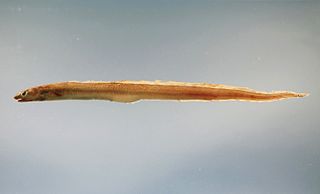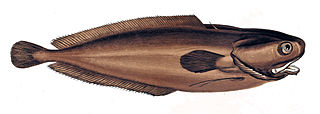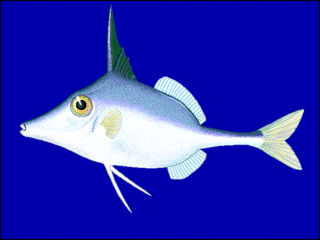 W
WThe cleftbelly trevally, also known as the cleftbelly kingfish, Kuweh trevally or thin crevalle, is a species of tropical marine fish of the jack family, Carangidae. The species inhabits coastal waters throughout the Indo-West Pacific region from South Africa in the west to Japan in the east, often found near the water's surface. The cleftbelly trevally is the only member of the genus Atropus and is distinguished by a number of anatomical characteristics, with a deep median groove in the belly giving the species its common name. It is not a large fish, growing to a maximum recorded length of 26.5 cm. Cleftbelly trevally are predatory fish, taking a variety of small crustaceans and fish. The species is of minor importance to fisheries throughout its range.
 W
WThe fire-bellied toads are a group of six species of small frogs belonging to the genus Bombina.
 W
WConger is a genus of marine congrid eels. It includes some of the largest types of eels, ranging up to 2 m (7 ft) or more in length, in the case of the European conger. Large congers have often been observed by divers during the day in parts of the Mediterranean Sea, and both European and American congers are sometimes caught by fishermen along the European and North American Atlantic coasts.
 W
WDoto is a genus of dendronotid sea slug, a nudibranch in the Family Dotidae. This genus feeds on hydroids, as reflected by its serrated radula.
 W
WFavia is a genus of reef-building stony corals in the family Mussidae. Members of the genus are massive or thickly encrusting colonial corals, either dome-shaped or flat, and a few are foliaceous. There is a great diversity of form even among individuals of the same species. The corallites project slightly above the surface of the coral and each has its own wall. In most species, the corallites are plocoid and in some, monocentric. The septa and costae linked to the corallite wall are well developed and covered by fine teeth. The polyps only extend and feed during the night. Each one has a small number of tapering tentacles which often have a darker coloured tip; these are called stinger tentacles, or sweeper tentacles. They use these to sweep the water to see if any other coral is in its area; if so, then they begin to sting the other coral. This is commonly known as coral war. Each coral is trying to make sure it has enough room around it so they can continue to grow and have more surface area for their offspring. The columella is parietal and spongy, and there are vesicles on both the endotheca and exotheca. Members of this genus are widespread in both the Atlantic Ocean and the Indo-Pacific.
 W
WGalaxea is a genus of colonial stony corals in the family Euphylliidae. Common names include crystal, galaxy, starburst and tooth coral. They are abundant on reefs in the Indo-Pacific region and the Red Sea. They are found in water less than 20 metres (66 ft) deep and favour turbid sites. They are sometimes kept in reef aquaria.
 W
WHemidactylus is a genus of the common gecko family, Gekkonidae. It has 168 described species, newfound ones being described every few years. These geckos are found in all the tropical regions of the world, extending into the subtropical parts of Africa and Europe. They excel in colonizing oceanic islands by rafting on flotsam, and are for example found across most of Polynesia. In some archipelagoes, cryptic species complexes are found. Geckos like to live in and out of houses. They have been introduced to Australia.
 W
WMonacanthus is a genus of filefishes.
 W
WThe genus Pan consists of two extant species: the chimpanzee and the bonobo. Taxonomically, these two ape species are collectively termed panins; however, both species are more commonly referred to collectively using the generalized term chimpanzees, or chimps. Together with humans, gorillas, and orangutans they are part of the family Hominidae. Native to sub-Saharan Africa, chimpanzees and bonobos are currently both found in the Congo jungle, while only the chimpanzee is also found further north in West Africa. Both species are listed as endangered on the IUCN Red List of Threatened Species, and in 2017 the Convention on Migratory Species selected the chimpanzee for special protection.
 W
WPterois is a genus of venomous marine fish, commonly known as lionfish, native to the Indo-Pacific. Also called zebrafish, firefish, turkeyfish, tastyfish or butterfly-cod, it is characterized by conspicuous warning coloration with red, white, creamy, or black bands, showy pectoral fins, and venomous spiky fin rays. Pterois radiata, Pterois volitans, and Pterois miles are the most commonly studied species in the genus. Pterois species are popular aquarium fish. P. volitans and P. miles are recent and significant invasive species in the west Atlantic, Caribbean Sea and Mediterranean Sea.
 W
WPtyodactylus is a genus of geckos, which are commonly known as fan-fingered geckos. The genus has 12 described species.
 W
WThe tadpole fish is a species of Gadidae fish native to the northeast Atlantic Ocean around the coasts of France, Ireland, and the United Kingdom and the North Sea. This species grows to a total length of 27.5 cm (10.8 in). It is of no importance to the commercial fishery industry, though it can be found in the aquarium trade and is displayed in public aquaria.
 W
WSchilbe is a genus of schilbid catfishes native to Africa. Some are colloquially called "butter catfishes", though this may also refer to the Asian genus Ompok of the family Siluridae.
 W
WThecadactylus is a gekko genus from the tropical Americas. They are known as the turnip-tailed geckos. The genus belongs to the gecko family Phyllodactylidae. Until 2007, it was believed to be monotypic, with T. rapicauda the sole species. Then however, the population from upstream southern Amazon basin was discovered to be very distinct and was named a new species, T. solimoensis. A third species was described in 2011.Thecadactylus oskrobapreinorum Köhler & Vesely, 2011 Thecadactylus rapicauda Houttuyn, 1782 – turniptail gecko Thecadactylus solimoensis Bergmann & Russell, 2007
 W
WThyone is a genus of sea cucumbers in the family Phyllophoridae.
 W
WTriacanthus is a genus in tripod fish family (Triacanthidae) native to the Indian Ocean and the western Pacific Ocean.